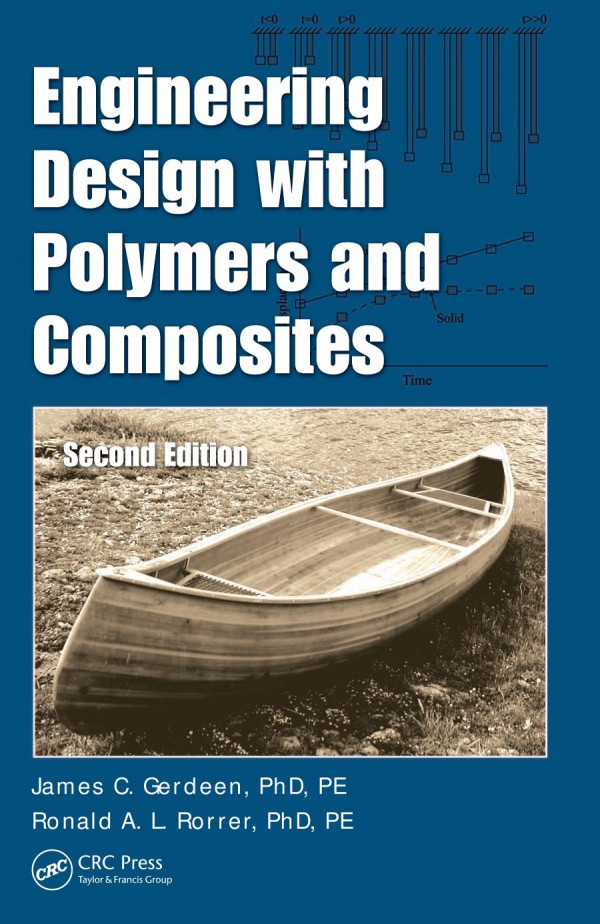Engineering Design with Polymers and Composites 2nd Edition by James Gerdeen, Ronald Rorrer ISBN 1439885532 9781439885536
$50.00 Original price was: $50.00.$35.00Current price is: $35.00.
Engineering Design with Polymers and Composites 2nd Edition by James C. Gerdeen, Ronald A.L. Rorrer – Ebook PDF Instant Download/Delivery: 1439885532, 9781439885536
Full download Engineering Design with Polymers and Composites 2nd Edition after payment
Product details:
ISBN 10: 1439885532
ISBN 13: 9781439885536
Author: James C. Gerdeen, Ronald A.L. Rorrer
Engineering Design with Polymers and Composites 2nd Edition:
Engineering Design with Polymers and Composites, Second Edition continues to provide one of the only textbooks on the analysis and design of mechanical components made from polymer materials. It explains how to create polymer materials to meet design specifications.
After tracing the history of polymers and composites, the text describes modern design concepts, such as weight-to-strength ratio and cost-to-strength ratio, for selecting polymers and composites for design applications. It also presents computer methods for choosing polymer materials from a database, for optimal design, and for laminated plate design.
New to the Second EditionThis edition rearranges many chapters and adds a significant amount of new material. Composites are now covered in two chapters, instead of one. This edition also includes entirely new chapters on polymer fusing and other assembly techniques, rapid prototyping, and piezoelectric polymers.
Suitable for mechanical and civil engineering students as well as practicing engineers, this book helps readers get an edge in the rapidly changing electromechanical industry. It gives them a fundamental foundation for understanding phenomena that they will encounter in real-life applications or through subsequent study and research.
Engineering Design with Polymers and Composites 2nd Edition Table of contents:
1. Introduction
- 1.1 Introduction
- 1.2 History of Polymers
- 1.3 History of Composites
- 1.4 Examples of Polymers and Composites in Use
- 1.5 Definitions and Classifications
- 1.6 Identification of Plastics
- 1.7 Raw Materials and Production of Polymers
- 1.8 Chemical Structures
- 1.9 Glass Transition and Melting Temperatures
2. Mechanical Properties of Polymers
- 2.1 Introduction
- 2.2 Tensile Properties
- 2.3 Static Failure Theories
- 2.4 Creep Properties
- 2.5 Relaxation Properties
- 2.6 Dynamic Properties
- 2.7 Large Strain Definitions
- 2.8 Analysis of Damping
- 2.9 Time Hardening Creep
- 2.10 Isochronous Creep Curves
3. Viscoelastic Behavior of Polymers
- 3.1 Mechanical Models
- 3.2 Mathematical Models
- 3.3 The Maxwell Fluid
- 3.4 The Kelvin Solid
- 3.5 The Four-Parameter Model
- 3.6 The Boltzmann Superposition Principle
- 3.7 Advanced Viscoelastic Models
- 3.8 The Viscoelastic Correspondence Principle
- 3.9 The Time–Temperature Equivalence Principle
4. Creep and Fatigue Failure
- 4.1 Creep Failure under Tension
- 4.2 Creep Failure under Compression
- 4.3 Fatigue of Polymers
- 4.4 Notch Sensitivity under Fatigue
- 4.5 Creep Buckling of Shells
5. Impact Strength and Fracture Toughness
- 5.1 Impact Strength
- 5.2 Fracture Toughness
- 5.3 Analysis of the Charpy and Izod Impact Tests using Fracture Mechanics
- 5.4 Analysis of Impact Specimens at the Nanoscale
6. Selection of Polymers for Design Applications
- 6.1 Introduction
- 6.2 Basic Material Properties
- 6.3 Performance Parameters
- 6.4 Loading Conditions and Geometrical Configurations
- 6.5 Availability of Materials
- 6.6 A Rectangular Beam in Bending
- 6.7 Weighting-Factor Analysis
- 6.8 Thermal Gradient through a Beam
- 6.9 Rating Factors for Various Loading Requirements
- 6.10 Design Optimization
- 6.11 Computer Database Design Selection Procedure
7. Design Applications of Some Polymers
- 7.1 Phenolic Resins with Fillers
- 7.2 Polycarbonate
- 7.3 Example Design with PC: Fan Impeller Blade
- 7.4 Example Design with PC: Snap/Fit Design
- 7.5 Example Design of PVC Pipe
- 7.6 Design with Fluorocarbon Resins
8. Composite Material Mechanics
- 8.1 Introduction
- 8.2 Composite Material Nomenclature and Definitions
- 8.3 Analysis of Composite Structures
- 8.4 Experimental Determination of Engineering Elastic Constants
9. Composite Laminate Failure
- 9.1 Strength Properties and Failure Theories
- 9.2 Stiffness of Laminated Composites
- 9.3 Thermal Stresses
- 9.4 Summary
10. Polymer Processing
- 10.1 Extrusion
- 10.2 Manufacture of PVC Pipe by Extrusion
- 10.3 Injection Molding
- 10.4 Thermoforming
- 10.5 Blow Molding
11. Adhesion of Polymers and Composites
- 11.1 Introduction
- 11.2 Fundamentals of Adhesion
- 11.3 Adhesives
- 11.4 Enhancement of Adhesion in Composites
- 11.5 Curing of Adhesives
- 11.6 Summary
12. Polymer Fusing and Other Assembly Techniques
- 12.1 Introduction
- 12.2 Heated Tool Welding
- 12.3 Ultrasonic Welding
- 12.4 Friction Welding
- 12.5 Laser Welding
- 12.6 Hot Gas
- 12.7 Resistance Welding
- 12.8 Induction Welding
- 12.9 Mechanical Fastener Connections
13. Tribology of Polymers and Composites
- 13.1 Introduction
- 13.2 Contact Mechanics
- 13.3 Surface Topography
- 13.4 Friction
- 13.5 Wear
- 13.6 PV Limit
- 13.7 Rolling and Sliding
- 13.8 Modification of Polymers for Friction and Wear Performance
- 13.9 Composites
- 13.10 Wear of Composites
- 13.11 Heat Generation in Sliding Polymer Systems
- 13.12 Special Considerations
- 13.13 Simulative Laboratory Testing
14. Damping and Isolation with Polymers and Composites
- 14.1 Introduction
- 14.2 Relevance of the Thermomechanical Spectrum
- 14.3 Damping Methods of Material Modification
- 14.4 Materials for Damping and Isolation
- 14.5 Fundamentals of Vibration Damping and Isolation
- 14.6 Role of Dampers
- 14.7 Damping Layers
15. Rapid Prototyping with Polymers
- 15.1 Introduction
- 15.2 Rapid Product Development, Tooling, and Manufacture
- 15.3 RP Techniques
- 15.4 RP Materials
- 15.5 Applications
People also search for Engineering Design with Polymers and Composites 2nd Edition:
what is a composite design engineer
composite design engineer jobs
engineering polymers definition
design polymers
polymer and plastics engineering
Tags:
James Gerdeen,Ronald Rorrer,Engineering,Design,Polymers,Composites




